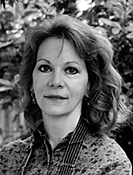BIOGRAPHY - Holly Hope Banks (Born 1957)

“Art is a creative way to express your opinion of the world around you. I like the language of art…it is visual, full of challenges. I like the fact that it is a solitary profession, dependent only on yourself, and once you have created, you can separate yourself from it--not like music, where you have an audience in the moment of expression.”
Born in Columbus, Ohio in 1957, Holly Hope Banks spent her childhood in a countryside setting surrounding her family’s home in northern Ohio. The young artist was fascinated with the natural world around her and was constantly drawing images based on her observations. Despite her early aptitude for visual art, her college years at the University of Toledo were initially filled with uncertainty about what course of study she should pursue until she took an “interest test” that revealed her unmistakable preference for the arts. Encouraged by the results, Banks took her first art class, and found that it was exactly what she wanted to do.
The art department at the University of Toledo was based at the nearby Toledo Museum of Art, which had a comprehensive collection of paintings from early Renaissance to 19th century eras. There, Banks was able to study examples of painting from these historical periods.
Banks’ college years were both challenging and productive. She was unswerving to her goals by working full-time in order to pay her tuition and living expenses, and went to school full time as well. In 1981 she graduated with a major in painting from the University of Toledo; and a year later, she was working as a registered copyist at the National Gallery of Art in Washington, D.C. The move to Washington, D.C. was in part a decision to further her study of painting in an environment rich with art museums and diverse collections. As a copyist at the National Gallery, Banks organized her work according to what she wanted to study at any particular time; for example, her exploration of how to paint skin tones led her to copy an image by the French baroque artist Simon Vouet (1590-1649); his masterpiece, St Jerome and the Angel cir.1620s.
Banks remained in Washington, D.C. until 1986 when she moved to Florida in order to be in a tropical climate. She continued to paint regularly, and to seek additional training. As she remarks, “I knew I needed more in-depth training and I was trying to find teachers to learn how to paint that higher caliber of the 19th C painters." Her initial thoughts were to pursue a Master’s degree while in Florida Then in 1993, she noticed a newspaper article announcing the formation of a new art studio, the Atelier of Plein-Air Studies, which offered training in the classical painting tradition originally developed by the Ecole des Beaux-Arts in Paris and tenants of the Boston school tradition through R H Ives Gammell, artists with whom she had some knowledge. After meeting with the Atelier’s founder, Allan Banks (whom she would marry in 1997), she knew Atelier training was the right course of action. Remembering this experience, she comments, “I had to throw everything I had learned out the window and start over. It was a challenging, but very exciting time for me”
Three years later, her studies at the Atelier were completed, and her exposure to the art world, both historical and contemporary, was about to expand dramatically. Trips to England and France in 1994 and 1995 provided not only an opportunity to see nineteenth century British and French painters that she admired, but also demonstrated a new-found confidence in her ability to study and learn from past masters. In 1996 she was one of five artists chosen to be part of a cultural exchange with the newly independent Russian Federation, an unprecedented chance to work and live with the Union of Russian Artists in St. Petersburg and Moscow.
By the late 1990s, Banks had a well established reputation as a realist painter. American Artist magazine identified her as one of ten prominent emerging artists in 1998, and she had won the Renee & Stephen McNeely Award for Best Representational Oil at the Audubon Artists 56th Annual Exhibition at the Salmagundi Club in New York. Since then, she has received two additional awards at the annual exhibition of the Audubon Artists, in 1999 and 2004, as well as multiple awards from the Catharine Lorillard Wolfe Art Club in 2004, 2009 and 2011. Her work has also been included in exhibitions in 2000, 2001, and 2011 in the Butler Institute of American Art. The highlight of her career and achievements was to have her work purchased by the Butler Institute of American Art in 2011, a pastel portrait of her mother as part of their permanent collection. In 2001, Banks ventured into writing about her process of creating imaginative paintings in a 2001 article for American Artist entitled “An Artistic Imagination”.
Banks’ recent work increasingly focuses on technical mastery of painting, imaginative subjects with multiple figures in the composition as well as a strong emphasis on storytelling. Evermore looking to the natural world that fascinated her as a young artist remains a consistent aspect of her painting, evolving with each new phase of development the time tested craftsmanship of genuine picture-making.
Janet Whitmore, Ph.D.
